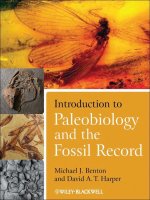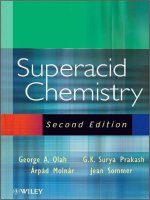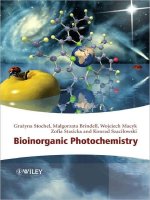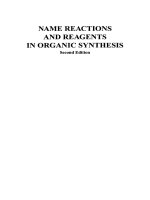gunn - essential forensic biology 2e (wiley, 2009)
Bạn đang xem bản rút gọn của tài liệu. Xem và tải ngay bản đầy đủ của tài liệu tại đây (17.31 MB, 437 trang )
Essential Forensic Biology
Second Edition
ffirs.indd i 11/17/2008 12:38:21 PM
ffirs.indd ii 11/17/2008 12:38:21 PM
Essential Forensic Biology
Second Edition
Alan Gunn
Liverpool John Moores University, Liverpool, UK
A John Wiley & Sons, Ltd., Publication
ffirs.indd iii 11/17/2008 12:38:21 PM
This edition fi rst published 2009, © 2009 by John Wiley & Sons Ltd.
Wiley-Blackwell is an imprint of John Wiley & Sons, formed by the merger of Wiley’s global
Scientifi c, Technical and Medical business with Blackwell Publishing.
Registered offi ce: John Wiley & Sons Ltd, The Atrium, Southern Gate, Chichester, West Sussex,
PO19 8SQ, UK
Other Editorial Offi ces:
9600 Garsington Road, Oxford, OX4 2DQ, UK
111 River Street, Hoboken, NJ 07030-5774, USA
For details of our global editorial offi ces, for customer services and for information about how to
apply for permission to reuse the copyright material in this book please see our website at
www.wiley.com/wiley-blackwell
The right of the author to be identifi ed as the author of this work has been asserted in accordance
with the Copyright, Designs and Patents Act 1988.
All rights reserved. No part of this publication may be reproduced, stored in a retrieval system, or
transmitted, in any form or by any means, electronic, mechanical, photocopying, recording or
otherwise, except as permitted by the UK Copyright, Designs and Patents Act 1988, without the prior
permission of the publisher.
Wiley also publishes its books in a variety of electronic formats. Some content that appears in print
may not be available in electronic books.
Designations used by companies to distinguish their products are often claimed as trademarks. All
brand names and product names used in this book are trade names, service marks, trademarks or
registered trademarks of their respective owners. The publisher is not associated with any product or
vendor mentioned in this book. This publication is designed to provide accurate and authoritative
information in regard to the subject matter covered. It is sold on the understanding that the publisher
is not engaged in rendering professional services. If professional advice or other expert assistance is
required, the services of a competent professional should be sought.
Library of Congress Cataloguing-in-Publication Data
Gunn, Alan.
Essential forensic biology / Alan Gunn. – 2nd ed.
p. ; cm.
Includes bibliographical references and index.
ISBN 978-0-470-75804-5 (HB) – ISBN 978-0-470-75803-8 (PB)
1. Forensic biology. I. Title.
[DNLM: 1. Forensic Medicine. W 700 G976e 2009]
QH313.5.F67G86 2009
363.25–dc22
2008040263
ISBN: 978-0-470-75804-5 (HB)
978-0-470-75803-8 (PB)
A catalogue record for this book is available from the British Library.
Set in 10/12 pt Sabon by SNP Best-set Typesetter Ltd., Hong Kong.
Printed in Singapore by Fabulous Printers Pte Ltd.
1 2009
ffirs.indd iv 11/17/2008 12:38:22 PM
To Sarah, who believes that no evidence is required in
order to fi nd a husband guilty.
ffirs.indd v 11/17/2008 12:38:22 PM
ffirs.indd vi 11/17/2008 12:38:22 PM
Contents
Acknowledgements xi
Introduction 1
PART A: HUMAN REMAINS: DECAY, DNA, TISSUES AND FLUIDS 9
Chapter One: The decay, discovery and recovery of human bodies 11
The dead body 11
The stages of decomposition 12
Factors affecting the speed of decay 28
Discovery and recovery of human remains 35
Determining the age and provenance of skeletonized remains 39
Future developments 41
Chapter Two: Body fl uids and waste products 45
Blood cells and blood typing 45
Methods for detecting blood 48
Confi rming the presence of blood 51
Bloodstain pattern analysis 51
Artifi cial blood 70
Post mortem toxicological analysis of blood 71
Saliva and semen 72
Vitreous humor 75
Faeces and urine as forensic indicators 77
Future directions 82
Chapter Three: Molecular biology 85
The structure of DNA 86
DNA sampling 87
DNA profi ling 88
Polymerase chain reaction 92
Short tandem repeat markers 97
Single nucleotide polymorphism markers 107
Determination of ethnicity 108
Determination of physical appearance 109
Determination of personality traits 110
Mobile element insertion polymorphisms 110
Mitochondrial DNA 112
RNA 115
DNA databases 116
Future developments 120
ftoc.indd vii 11/17/2008 12:38:39 PM
viii CONTENTS
Chapter Four: Human tissues 123
The outer body surface 123
Hair 138
Bones 142
Teeth 151
Future developments 159
Chapter Five: Wounds 163
Defi nitions 163
Blunt force injuries 165
Sharp force traumas 172
Bone damage 180
Additional aspects of wound interpretation 183
Asphyxia 184
Pathology associated with drug use 190
Gunshot wounds 192
Bite marks 200
Burns and scalds 203
Ageing of wounds 205
Post mortem injuries 207
Future developments 209
PART B: INVERTEBRATES AND VERTEBRATES 211
Chapter Six: Invertebrates 1: biological aspects 213
An introduction to invertebrate biology 213
Invertebrates as forensic indicators in cases of murder or
suspicious death 214
Invertebrates as a cause of death 238
Invertebrates as forensic indicators in cases of neglect and animal
welfare 241
The role of invertebrates in food spoilage and hygiene litigation 243
The illegal trade in invertebrates 246
Invertebrate identifi cation techniques 247
Future directions 250
Chapter Seven: Invertebrates 2: practical aspects 253
Calculating the PMI/time since infestation from invertebrate
development rates 254
Complicating factors affecting earliest oviposition date calculations 260
Determination of the PMI using invertebrate species composition 266
Determination of the PMI using ectoparasites 267
Determination of movement from invertebrate evidence 267
Invertebrate evidence in cases of wound myiasis and neglect 269
Detection of drugs, toxins and other chemicals in invertebrates 271
Obtaining human/vertebrate DNA evidence from invertebrates 271
Determining the source and duration of invertebrate infestations
of food products 272
ftoc.indd viii 11/17/2008 12:38:39 PM
CONTENTS ix
Collecting invertebrates for forensic analysis 273
Killing and preserving techniques for invertebrates 276
Future directions 279
Chapter Eight: Vertebrates 283
Introduction 284
Vertebrate scavenging of human corpses 284
Vertebrates causing death and injury 291
Neglect and abuse of vertebrates 292
Vertebrates and drugs 293
Vertebrates and food hygiene 295
Illegal trade and killing of protected species of vertebrates 295
Identifi cation of vertebrates 298
Future directions 309
PART C: PROTISTS, FUNGI, PLANTS AND MICROBES 313
Chapter Nine: Protists, fungi and plants 315
Introduction 316
Protists 316
Fungi 321
Plants 324
Plant secondary metabolites as sources of drugs and poisons 347
Illegal trade in protected plant species 351
Future directions 353
Chapter Ten: Bacteria and viruses 355
Introduction 355
The role of microorganisms in the decomposition process 356
Microbial profi les as identifi cation tools 357
Microbial infections and human behaviour 370
Microbial infections that can be mistaken for signs of criminal
activity 372
The use of microorganisms in bioterrorism 373
Future directions 390
References 393
Index 417
ftoc.indd ix 11/17/2008 12:38:39 PM
ftoc.indd x 11/17/2008 12:38:39 PM
Acknowledgements
Thanks to Sarah and to all of the academic and technical staff at the School of
Biological & Earth Sciences, Liverpool John Moores University who helped me
along the way.
flast.indd Sec1:xi 11/17/2008 12:38:56 PM
flast.indd Sec1:xii 11/17/2008 12:38:57 PM
Introduction
Essential Forensic Biology, Second Edition Alan Gunn
© 2009 John Wiley & Sons, Ltd
The word ‘ forensic ’ derives from the Latin forum meaning ‘ a market place ’ : in
Roman times this was the where business transactions and some legal proceedings
were conducted. For many years the term ‘ forensic ’ had a restricted defi nition and
denoted a legal investigation but it is now commonly used for any detailed analysis
of past events i.e. when one looks for evidence. For example, tracing the source of
a pollution incident is now sometimes referred to as a ‘ forensic environmental
analysis ’ , determining past planetary confi gurations is referred to as ‘ forensic astron-
omy ’ , whilst historians are said to examine documents in ‘ forensic detail ’ . For the
purposes of this book, ‘ forensic biology ’ is defi ned broadly as ‘ the application of
the science of biology to legal investigations ’ and therefore covers human anatomy
and physiology, organisms ranging from viruses to vertebrates and topics from
murder to the trade in protected plant species.
Although forensic medicine and forensic science only became specialised areas of
study within the last 200 or so years, their origins can be traced back to the earliest
civilisations. The fi rst person in recorded history to have medico - legal responsibili-
ties was Imhotep, Grand Vizier, Chief Justice, architect and personal physician to
the Egyptian pharaoh Zozer (or Djoser). Zozer reigned from 2668 – 2649 BC and
charged Imhotep with investigating deaths that occurred under suspicious circum-
stances. The codifi cation of laws was begun by the Sumerian king Ur - Nammu (ca
2060 BC) with the eponymous ‘ Ur - Nammu Code ’ in which the penalties of various
crimes were stipulated whilst the fi rst record of a murder trial appears on clay tablets
inscribed in 1850 BC at the Babylonian city of Nippur.
In England, the offi ce of coroner dates back to the era of Alfred the Great (871 –
899) although his precise functions at this time are not known. It was during the
reign of Richard I (1189 – 1199) that the coroner became an established fi gure in the
legal system. The early coroners had widespread powers and responsibilities that
included the investigation of crimes ranging from burglary to cases of murder and
suspicious death. The body of anyone dying unexpectedly had to be preserved for
inspection by the coroner, even if the circumstances were not suspicious. Failure to
do so meant that those responsible for the body would be fi ned, even though it
might have putrefi ed and created a noisome stench by the time he arrived. It was
therefore not unusual for unwanted bodies to be dragged away at night to become
another village ’ s problem. The coroner ’ s responsibilities have changed considerably
over the centuries but up until 1980 he was still expected to view the body of anyone
dying in suspicious circumstances.
cintro.indd 1 11/17/2008 12:37:45 PM
2 INTRODUCTION
Although the coroner was required to observe the corpse he did not undertake
an autopsy. In England and other European countries, the dissection of the human
body was considered sinful and was banned or permitted only in exceptional cir-
cumstances until the nineteenth century. Most Christians believed that the body had
to be buried whole otherwise the chances of material resurrection on Judgement
Day were slight. The fi rst authorized human dissections took place in 1240 when
the Holy Roman Emperor Frederick II decreed that a corpse could be dissected at
the University of Naples every fi ve years to provide teaching material for medical
students. Subsequently, other countries followed suit, albeit slowly. In 1540, King
Henry VIII became the fi rst English monarch to legislate for the provision of human
dissections by allowing the Company of Barber Surgeons the corpses of four dead
criminals per annum and in 1663, King James II increased this fi gure to six per
annum. Subsequently, after passing the death sentence, judges were given the option
of permitting the body of the convict to be buried (albeit without ceremony) or to
be exposed on a gibbet or dissected. Nevertheless, the lack of bodies and an eager
market among medical colleges created the trade of body snatching. Body snatchers
were usually careful to leave behind the coffi n and the burial shroud because taking
these would count as a serious criminal offence – which was potentially punishable
by hanging. Removing a body from its grave was classed as merely a misdemeanour.
The modern day equivalent is the Internet market in human bones of uncertain
provenance (Huxley & Finnegan, 2004 ; Kubiczek & Mellen, 2004 ). A recent notori-
ous case arose when it was discovered that the body of the eminent journalist
Alistair Cooke had been plundered whilst ‘ resting ’ in a funeral parlour in New York.
Alistair Cooke died on March 30
th
2004 and despite the fact that he was 95 years -
old at the time of his death and had been suffering from cancer, his arms, legs and
pelvis were surreptitiously removed and sold to a tissue processing company. There
is a perfectly legal market for bones and other body tissues for use in surgery or as
dental fi ller but it is also highly lucrative and some people have been tempted into
criminal behaviour.
Although the ancient Greeks are known to have performed human dissections,
Julius Caesar (102/100 – 44 BC) has the dubious distinction of being the fi rst
recorded murder victim in history to have undergone an autopsy. After being assas-
sinated, his body was examined by the physician Antistius who concluded that
although Julius Caesar had been stabbed 23 times, only the second of these blows,
struck between the 1
st
and 2
nd
ribs, was fatal. The fi rst recorded post mortem to
determine the cause of a suspicious death took place in Bologna in 1302. A local
man called Azzolino collapsed and died suddenly after a meal and his body very
quickly became bloated whilst his skin turned olive and then black. Azzolino had
many enemies and his family believed that he had been poisoned. A famous surgeon,
Bartolomeo de Varignana was called upon to determine the cause and he was per-
mitted to undertake an autopsy. He concluded that Azzolino had died as a conse-
quence of an accumulation of blood in veins of the liver and that the death was
therefore not suspicious. Although this case set a precedent, there are few records
from the following centuries of autopsies being undertaken to determine the cause
of death in suspicious circumstances.
The fi rst book on forensic medicine may have been that written by the Chinese
physician Hsu Chich - Ts ’ si in the 6
th
century AD but this has since been lost. Subse-
cintro.indd 2 11/17/2008 12:37:45 PM
INTRODUCTION 3
quently, in 1247, the Chinese magistrate Sung Tz ’ u wrote a treatise entitled ‘ Xi
Yuan Ji Lu ’ that is usually translated as ‘ The Washing Away of Wrongs ’ , and this
is generally accepted as being the fi rst forensic textbook (Peng & Pounder, 1998 ).
Sung Tz ’ u would also appear to be the fi rst person to apply an understanding of
biology to a criminal investigation as he relates how he identifi ed the person guilty
of a murder by observing the swarms of fl ies attracted to the bloodstains on the
man ’ s sickle. In Europe, medical knowledge advanced slowly over the centuries and
forensic medicine really only started to be identifi ed as a separate branch of medicine
in the 1700s (Chapenoire & Benezech, 2003 ). The French physician Francois -
Emanuel Foder é (1764 – 1835) produced a landmark 3 volume publication in 1799
entitled Les lois é clair é es par les sciences physiques: ou Trait é de m é decine - l é gale
et d ’ hygi è ne publique that is recognised as a major advancement in forensic medi-
cine. In 1802, the fi rst chair in Forensic Medicine in the UK was established at
Edinburgh University and in 1821 John Gordon Smith wrote the fi rst book on
forensic medicine in the English language entitled ‘ The Principles of Forensic
Medicine ’ .
Today, forensic medicine is a well - established branch of the medical profession.
Clinical forensic medicine deals with cases in which the subject is living (e.g. non -
accidental injuries, child abuse, rape) whilst forensic pathology deals with investiga-
tions into causes of death that might result in criminal proceedings (e.g. suspected
homicide, fatal air accident). Pathology is the study of changes to tissues and organs
caused by disease, trauma and toxins etc. Theoretically, any qualifi ed medical doctor
can perform an autopsy but in practise, at least in the UK, they are conducted by
those who have received appropriate advanced training.
The majority of deaths are not suspicious so an autopsy is unlikely to take place.
Indeed, even if a doctor requests an autopsy, the relatives of the dead person must
give their permission. Some religious groups are opposed to autopsies and/or require
a person to be buried within a very short period of death so this may be refused.
For example, many Muslims, orthodox Jews and some Christian denominations
remain opposed to autopsies. Some doctors are concerned about how few autopsies
take place since it is estimated that 20 – 30% of death certifi cates incorrectly state
the cause of death (Davies et al. 2004 ). The errors are seldom owing to incompe-
tence or a ‘ cover - up ’ but a consequence of the diffi culty of diagnosing the cause of
death without a detailed examination of the dead body. Unfortunately, there are
rogue elements in all professions and Dr Harold Shipman is believed to have mur-
dered over 200 mostly elderly patients over the course of many years through the
administration of morphine overdoses and then falsifi
ed their death certifi cates
(Pounder, 2003 ). Dr Shipman ’ s victims suffered from a range of chronic ailments
and because of their age and infi rmities nobody questioned the certifi cates he signed.
In addition, he also falsifi ed his computer patient records so that it would appear
that the patient had suffered from the condition that he claimed had led to their
death. He would sometimes do this within hours of administering a fatal dose of
morphine. Ultimately, suspicions were aroused and several of his victims who had
been buried were disinterred and subjected to an autopsy. The fi ndings indicated
that although they may have been infi rm they had not died as a consequence of
disease. They did, however, contain signifi cant amounts morphine: morphine resi-
dues can be detected in buried bodies for several years after death. Dr Shipman had
cintro.indd 3 11/17/2008 12:37:45 PM
4 INTRODUCTION
therefore, surprisingly for a doctor, chosen one of the worst poisons in terms of
leaving evidence behind. Dr Shipman was found guilty of murdering 15 of his
victims in January 2000 and subsequently committed suicide whilst in prison.
In England and Wales, when a body is discovered in suspicious circumstances the
doctor issuing the death certifi cate or the police will inform the coroner and they
can then request that an autopsy is performed regardless of the wishes of the rela-
tives. In this case, the autopsy will usually be undertaken by one of the doctors on
the Home Offi ce List of pathologists. As of 1 April 2006, there were 38 of these
each of whom covered one of 8 regions of England and Wales. The name is a bit
of a misnomer because although they are accredited by the Home Offi ce, they are
not employed by the Home Offi ce. Scotland has its own laws and the Procurator
Fiscal is the person who decides whether a death should be considered suspicious
and also whether one or two pathologists should conduct the autopsy. [In England
and Wales the pathologist usually works on their own.]. The situation in Northern
Ireland is slightly different again with pathology services provided by The State
Pathologist ’ s department. Other countries have their own arrangements and there
are calls for a thorough overhaul for the provision of forensic services in England
and Wales and of the coroner system in particular (e.g. Whitwell, 2003 ).
Animals and plants have always played a role in human affairs, quite literally in
the case of pubic lice, and have been involved in legal wrangles ever since the fi rst
courts were convened. Disputes over ownership, the destruction of crops and the
stealing or killing of domestic animals can be found in many of the earliest records.
For example, Hammurabi, who reigned over Babylonia during 1792 – 1750 BC,
codifi ed many laws relating to property and injury that subsequently became the
basis of Mosaic Law. Amongst these laws it was stated that anyone stealing an
animal belonging to a freedman must pay back ten fold whilst if the animal belonged
to the court or a god, then he had to pay back thirty fold. Animals have also found
themselves in the dock accused of various crimes. In the Middle Ages there were
several cases in which pigs, donkeys and other animals were executed by the public
hangman following their trial for murder or sodomy. The judicial process was
considered important and the animals were appointed a lawyer to defend them and
they were tried and punished like any human. In 1576, the hangman brought shame
on the German town of Schweinfurt by publicly hanging a pig in the custody of
the court before due process had taken place. He never worked in the town again
and his behaviour is said to have given rise to the term ‘ Schweinfurter Sauhenker ’
(Schweinfurt sow hangman) to describe a disreputable scoundrel (Evans, 1906 ).
However, the phrase has now fallen out of fashion. Today, it is the owner of a
dangerous animal who is prosecuted when it wounds or kills someone, although it
may still fi nd itself facing the death penalty.
During the nineteenth century, a number of French workers made detailed obser-
vations on the sequence of invertebrate colonisation of human corpses in cemeteries
and attempts were made to use this knowledge to determine the time since death
in murder investigations (Benecke, 2001 ). Thereafter, invertebrates were used to
provide evidence in a sporadic number of murder investigations but it was not until
the 1980s that their potential was widely recognised. Part of the reason for the slow
development is the problem of carrying out research that can be applied to real case
situations. The body of the traditional experimental animal, the laboratory rat,
cintro.indd 4 11/17/2008 12:37:45 PM
INTRODUCTION 5
bears so little resemblance to that of a human being that it is diffi cult to draw
meaningful comparisons from its decay and colonisation by invertebrates. Pigs, and
in particular foetal pigs are therefore the forensic scientists ’ usual choice of corpse
although America (where else?) has a ‘ Body Farm ’ in which dead humans can be
observed decaying under a variety of ‘ real life (death?) situations ’ (Bass & Jefferson,
2003 ). Leaving any animal to decay inevitably results in a bad smell and attracts
fl ies – so it requires access to land far from human habitation. It also often requires
the body to be protected from birds, dogs, and rats that would drag it away. Con-
sequently, it is diffi cult both to obtain meaningful replicates and to leave the bodies
in a ‘ normal ’ environment. Even more importantly, these types of experiments
confl ict with European Union Animal By Products Regulations that require the
bodies of dead farm and domestic animals to be disposed of appropriately to avoid
the spread of disease – and leaving a dead pig to moulder on the ground clearly
contravenes these.
The use of animals other than insects in forensic investigations has proceeded
more slowly and that of plant - based evidence has been slower still. The fi rst use of
pollen analysis in a criminal trial appears to have taken place in 1959 (Erdtman,
1969 ) and although not widely used in criminal trials since then its potential is now
being increasingly recognised (Coyle, 2004 ). By contrast, the use of plants and other
organisms in archaeological investigations has been routine for many years. Micro-
bial evidence has seldom featured in criminal trials although this is likely to change
with the development of new methods of detection and identifi cation and the con-
cerns over bioterrorism.
By contrast to the slow progress in the use of animal and plant - based evidence,
the use of molecular biology in forensic science is now well established and it is an
accepted procedure for the identifi cation of individuals. This is usually on the basis
of DNA recovered from blood and other body fl uids or tissues such as bone marrow
and Jobling & Gill (2004) provide a thorough review of current procedures and
how things may develop in the future. The use of molecular biology for forensic
examination of non - human DNA is less advanced, although this situation will prob-
ably improve in the near future as DNA databases become established (Coyle,
2007 ). When this happens, animals and plants can be expected to play a larger part
in legal proceedings.
One of the major stumbling blocks to the use of biological evidence in English
trials is the nature of the legal system (Pamplin, 2004 ). In a criminal prosecution
case, the court has to be sure ‘ beyond all reasonable doubt ’ before it can return a
guilty verdict. The court therefore requires a level of certainty that science can rarely
provide. Indeed, science is based upon hypotheses and a scientifi c hypothesis is one
that can be proved wrong – provided that one can fi nd the evidence. Organisms are
affected by numerous internal and external factors and therefore the evidence based
upon them usually has to have qualifi cations attached to it. For example, suppose
the pollen profi le found on mud attached to the suspect ’ s shoes was similar to that
found at the site of the crime: this suggests a possible association but it would be
impossible to state beyond reasonable doubt that there are not other sites that might
have similar profi les – unlikely perhaps, but not beyond doubt. Lawyers are, quite
correctly, experts at exploiting the potential weaknesses of biological evidence
because it is seldom possible for one to state there is no alternative explanation for
cintro.indd 5 11/17/2008 12:37:45 PM
6 INTRODUCTION
the fi ndings or an event would never happen. Within civil courts, biological evidence
has greater potential since here the ‘ burden of proof ’ is based upon ‘ the balance of
probabilities ’ .
Although all biological evidence has its limitations, it can prove extremely useful
in answering many of the questions that arise whenever a body is found under sus-
picious circumstances. The fi rst question is, of course, are the remains human? This
might be obvious if the body is whole and fresh or even if there is just a skull but
sometimes there may be no more than a single bone or some old bloodstains. Assum-
ing that the remains are human, biological evidence can also help to answer the
subsequent questions (Table A ).
Similar sorts of questions arise in the cases of wildlife crime (e.g. killing of / trade
in protected species), neglect of humans and domestic animals, miss - selling of animal
products, and food contamination. This book is intended to demonstrate how an
understanding of biology can answer all these questions and is designed for under-
graduates who may have a limited background in biology and not the practicing
forensic scientist. I have therefore attempted to keep the terminology simple whilst
still explaining how an understanding of biological characteristics can be used to
provide evidence. Descriptions of potential sources of biological evidence and tests
that could be performed upon it continue to grow at a bewildering rate. However,
to be truly useful any test / source of evidence should be accurate, simple, affordable,
and deliver results within an acceptable time period (Table B ). With such a large
subject base, it is impossible to cover all topics in depth and readers wishing to
identify a maggot or undertake DNA analysis should consult one of the more
advanced specialist texts in the appropriate area. Similarly, those wishing more
detailed coverage of individual cases would be advised to consult the excellent books
by Erzinclioglu (2000) , Goff (2000) , Greenberg & Kunich (2002) and Smith (1986) .
Where information would not otherwise be easily accessible to undergraduate stu-
dents, I have made use of web - based material although the usual caveats apply to
such sources.
At the start of each chapter, I have produced a series of ‘ objectives ’ to illustrate
the material covered. They are written in the style of examination essay questions,
so that the reader might use them as part of a self - assessment revision exercise.
Similarly, at the end of each chapter I have produced a number of questions to test
knowledge and recall of factual information. Also at the end of each chapter, I have
made some suggestions for undergraduate projects. Because the usefulness of bio-
Table A Questions arising when a body or stains are found in suspicious circumstances
Are the remains or stains of human origin?
Who is the victim?
What was the cause of death?
How long ago did the victim die?
Did the victim die immediately or after a period of time – and if so, how long?
Did the person die at the spot where their body was found?
Did the person die of natural causes, an accident or a criminal act?
If the person was killed as a result of a criminal act who was responsible?
cintro.indd 6 11/17/2008 12:37:46 PM
INTRODUCTION 7
logical material as forensic evidence depends on a thorough understanding of basic
biological processes and the factors that affect them, there is plenty of scope for
simple projects based upon identifying species composition or that measure growth
rates. Obviously, for the majority of student projects cost, time and facilities will
be serious constraints; DNA analysis can be extremely expensive and requires spe-
cialist equipment. Similarly, the opportunities to work with human tissues or suita-
bly sized pigs may not exist. However, worthwhile work can still be done using the
bodies of laboratory rats and mice or meat and bones bought from a butcher as
substitute corpses with plants and invertebrates as sources of evidence.
Table B Characteristics of an ideal forensic test
Accurate: The results must stand up to intense scrutiny in court
Sensitive: Many forensic samples are extremely small and are fi nite (i.e. one cannot collect
more material once it used up)
Specifi c: If the test also cross - reacts with other materials then its accuracy will be
compromised.
Quick: Investigations cannot be allowed to drag on. If there is a chance that a criminal
might offend again they must be apprehended and charged as soon as possible. It is also
unfair to deprive a suspect of their liberty for long periods whilst time - consuming tests
are conducted.
Simple: The more complex a test becomes the more opportunity there is for mistakes to be
made. It also becomes expensive to train people to conduct the tests.
Reliable and repeatable: It is essential that a test can be replicated by other workers at
other laboratories.
Affordable: Financial considerations are important. Exceedingly expensive tests cannot be
used on a routine basis.
Equipment and reagents are readily available: The effectiveness of the test will be
compromised if equipment becomes unusable through lack of spare parts or reagents are
diffi cult to obtain.
cintro.indd 7 11/17/2008 12:37:46 PM
cintro.indd 8 11/17/2008 12:37:46 PM
Human Remains:
Decay, DNA,
Tissues and Fluids
PART A
The decay, discovery and
recovery of human bodies
1
The d ead b ody
The time before a person dies is known as the ante mortem period whilst that after
death is called the post mortem period. The moment of death is called the ‘ agonal
Chapter o utline
The Dead Body
The Stages of Decomposition
Factors Affecting the Speed of Decay
Discovery and Recovery of Human Remains
Determining the Age and Provenance of Skeletonized Remains
Future Developments
Quick Quiz
Project Work
Objectives
Compare the chemical and physical characteristics of the different stages of
decomposition.
Explain how a body ’ s rate of decomposition is affected by the way in which
death occurred and the environment in which it is placed.
Compare the conditions that promote the formation of adipocere and of
mummifi cation and how these processes preserve body tissues.
Compare and contrast the various techniques by which a dead body may be
located and retrieved.
Evaluate the potential and limitations of radiocarbon dating and stable
isotope analysis as means of determining the age and geographical origin
of human remains.
Essential Forensic Biology, Second Edition Alan Gunn
© 2009 John Wiley & Sons, Ltd
12 THE DECAY, DISCOVERY AND RECOVERY OF HUMAN BODIES
period ’ – the word being derived from ‘ agony ’ because it used to be believed that
death was always a painful experience. Either side of the moment of death is the
peri mortem period although there is no consensus about how many hours this
should encompass. It is important to know in which of these time periods events
took place in order to determine their sequence, the cause of death and whether or
not a crime might have been committed. Similarly, it is important to know the length
of the post mortem period, referred to as the post mortem interval (PMI) because
by knowing exactly when death occurred it is possible, amongst other things, to
either include or exclude the involvement of a suspect. The study of what happens
to remains after death is known as ‘ taphonomy ’ and the factors that affect the
remains are called ‘ taphonomic processes ’ . Thus, burning, maggot feeding, and
cannibalism are all examples of taphonomic processes.
When investigating any death it is essential to keep an open mind as to the pos-
sible causes. For example, if the partially clothed body of a woman is found on an
isolated moor, there are many possible explanations other than she was murdered
following a sexual assault. First of all, she may have lost some of her clothes after
death through them decaying and blowing away or from them being ripped off by
scavengers (Chapter 8 ). Secondly, she may have been a keen rambler who liked the
open countryside. Most people die of natural causes and she may have suffered
from a medical condition that predisposed her to a heart attack, stroke, or similar
potentially fatal condition whilst out on one of her walks. Another possibility is
that she may have committed suicide: persons with suicidal intent will sometimes
choose an isolated spot in which to die. Another explanation for the woman ’ s death
would be that she had suffered an accident, such as tripping over a stone, landing
badly and receiving a fatal blow to her head. And, fi nally, it is possible that she was
murdered. All of these scenarios must be considered in the light of the evidence
provided by the scene and the body.
The s tages of d ecomposition
After we die our body undergoes dramatic changes in its chemical and physical
composition and these changes can provide an indication of the PMI. The changes
also infl uence the body ’ s attractiveness to detritivores – organisms that consume
dead organic matter – and their species composition and abundance can also be
used as indicators of the PMI. Furthermore, the post mortem events may preserve
or destroy forensic evidence as well as bring about the formation of artefacts that
need to be recognized for what they are. An understanding of the decay process and
the factors that infl uence it is therefore essential for the interpretation of dead
human and animal remains.
The stages of decomposition in terrestrial environments can be loosely divided
into four stages: fresh, bloat, putrefaction, and putrid dry remains. However, these
stages merge into one another and it is impossible to separate them into discrete
entities. In addition, a body seldom decays in a uniform manner. Consequently, part
of the body may become reduced to a skeleton whilst another part continues to
retain fl eshy tissue.









